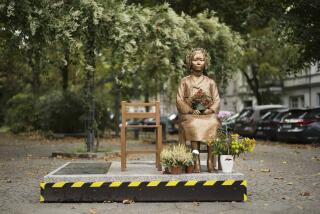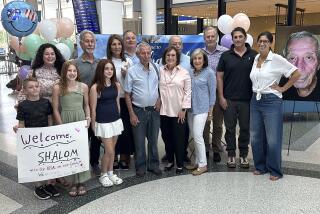Raising a child to be Jewish and German
- Share via
One recent warm afternoon, I buried a miniature treasure chest filled with shiny “gold” coins and smooth “gemstones” for my young daughter to find in the sands along the Rhine at our favorite picnic spot.
When I called her over and showed her the cartoon-perfect image of the chest’s edge poking out of the sand, her face lighted up in excitement. After minutes of furious digging, she pulled the chest to the surface and exclaimed in German, “Papa! Piraten Schatz!” (“Pirate treasure!”), followed by a more conspiratorial, “Shhh, nicht verraten!” (“Don’t tell anyone!”)
It was one of those unforgettable moments, and something of a salve for the last shiny object my daughter had found just weeks earlier. It was a bronze-plated cobblestone on the sidewalk outside an apartment house in our Duesseldorf neighborhood. When she was a 2-year-old in a stroller, explaining its significance to her was easy — it was simply a shiny object, and she enjoyed spotting them all around the city. But now she’s 5, and things have started to become more complicated, especially when she points to the lettering etched onto the metal. I finally told her the truth: The cobblestones commemorate the Jews who once lived in these buildings.
“We’re Jews, right, Papa?”
“Yes, sweetheart, we are.”
“What happened to those people?”
“They were killed.”
“That’s bad, Papa! By who?”
“By Nazis, honey.”
“What are Nazis?”
“They were bad Germans.”
“I’m German, aren’t I, Papa?”
“Yes, German and American. The best of both.”
This year, Germany marked the 65th anniversary of the end of the war and the liberation of its many former concentration camps with a series of appropriately grim state ceremonies. But while the horror of Germany’s Nazi past has few if any precedents in human history, the country’s attempts to publicly confront its past are similarly unrivaled. Unlike so many other nations, Germany delivers its apologies readily. Memorials, monuments and museums are scattered across the country, and Berlin is so chock-full of them that they’ve become the city’s de facto tourist attractions.
By comparison, Russia has only just acknowledged the Katyn massacre, the United States apologized for slavery about a year ago, and we still haven’t fully acknowledged our mistreatment of Native Americans. Meanwhile, Turkey continues to deny the Armenian holocaust, and Japan refutes its use of wartime sexual slavery.
That said, it remains an unusual experience to live as a Jew in a nation that systematically murdered 1.5 million Jewish children, among millions of others. My way of dealing with it has been to examine Duesseldorf’s own topography of terror. There’s little sign of Judaism left. One thousand years of vibrant Ashkenazi life in the Rhineland has seemingly disappeared into the ashes of Auschwitz and other death camps in the epochal equivalent of an eye blink. But I’ve learned that a beloved city park was built partly with Jewish slave labor, and that the old freight yard near my daughter’s kindergarten was used to ship Jews to the ghettos and concentration camps in Poland and beyond. They were processed there —1,000 at a time — in front of their former neighbors, then forced to sleep in the city’s (decidedly unkosher) slaughterhouse before being marched several kilometers in broad daylight with heavy luggage to waiting trains, for which they were forced to purchase “tickets.”
On the other side of town are the remnants of the old Jewish cemetery. The graves start out in Hebrew and then switch to mostly German as the population assimilated. During the 1920s, the tombstones were costly Bauhaus-inspired slabs; a few years later they grow smaller, more makeshift, and eventually crumble from the neglect of a nearly extinct community. The community’s once-stately synagogue in the center of town was so solidly built that it survived the fires of Kristallnacht. It was later dismantled brick by brick, with the congregation invoiced for the destruction.
The new synagogue is in my small neighborhood. It’s protected by concrete barriers, remote cameras, a bulletproof entrance and free 24-hour police protection. It nonetheless remains an attractive site, although I find little solace inside. As is typical in Germany, it’s an Orthodox congregation of mostly immigrants from Eastern Europe. I’m not religious, and I’m one of the few there who speak English. Aside from tribal affiliation, I’m not sure what else we have in common. Without the help of my small Reform congregation back home in the U.S., I feel it’s left to me to teach my daughter about Judaism. It’s becoming increasingly clear to me that I’m doing a journeyman’s job of it at best.
Then there’s my daughter’s other heritage. She comes from a family of resisters, smugglers and ultimately orphans, but as with so many German family trees, there’s at least one really bad apple whose actions may have contributed to the need for commemorative cobblestones.
These are issues that I will no doubt need to address as she grows older. But for now, she has bigger concerns. She’s learning two languages, struggling to balance her little pink bike without training wheels and excitedly contemplating where to hide her pirate’s bounty.
Andrew D. Blechman is the author of “Leisureville: Adventures in a World Without Children” and “Pigeons: The Fascinating Saga of a Revered and Reviled Bird.”


